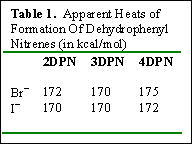
ACS PRF | ACS
All e-Annual Reports

43516-AC6
Experimental Studies of Topological Effects on Spin Properties in Open-Shell Hydrocarbons
Our work involves studies of triradicals with complicated electronic structures. 5-Dehydro-1,3-quinodimethane (5-dehydro-m-xylylene, DMX) is a pps triradical. Simple structure considerations predict that, while the triradical should have 3 singly occupied molecular orbitals, the electrons in those orbitals should be low-spin coupled, in violation of Hund's rule, and creating the first known example of an “open-shell doublet” electronic ground state hydrocarbon. Previous work from our laboratory led to the determination of the absolute heat of formation of 5-DMX. Further investigations are being carried out on DMX and related systems. Recent work has focused on providing experimental evidence for the doublet ground state of 5-DMX. We are currently attempting to use dissociation kinetics to demonstrate the differences between the electronic structures of the different triradical isomers. Initial experiments have been carried out with 2-, 3-, and 4-dehydrophenyl nitrenes (2-, 3-, and 4DPN, respectively). The dehydrophenyl nitrenes were investigated by using energy-resolved collision-induced dissociation of halophenylnitrene anions, as shown in eq 1. By measuring the halide dissociation energy, it is possible to determine the apparent heats of formation of the dehydrophenyl nitrenes, listed in Table 1. As can be seen in Table 1, the apparent heats of formation for 2- and 4DPN are found to be dependent on the halide leaving group used in the experiment, where the heat of formation of 3DPN is invariant with respect to halide. We interpret the data in light of the spin properties of the products being formed. Formation of high-spin products from low-spin reactants requires an intersystem crossing (ISC). If the ISC is slow on the experimental time scale, it leads to a kinetic shift in the formation of the product, which is manifested in the thermochemistry as a high apparent heat of formation. Increasing the size of the halogen leads to an increased rate of ISC by the heavy atom affect, such that the kinetic shift will be less pronounced when using larger halide ions, and the measured apparent heat of formation will be lower. Spin-allowed dissociation does not require ISC and therefore should not exhibit a heavy atom effect. Given the results for the DPNs, we conclude that the 2- and 4-isomers suffer from slow ISC, indicating that they have high-spin (quartet) ground electronic states. From our modeling, we are able to estimate the rate of ISC in the dissociation process. These experiments provide the first experimental confirmation of the low-spin ground state for 3DPN. Future studies will involve the isomers of DMX. As part of an investigation of the effects of substitution on the electronic properties of the DMX triradicals, we have carried out a study to determine the electronic effects of nitrogen in an aromatic ring. By measuring the acidities of nicotinic (NA) and isonicotinic (INA) acids, we have determined the Hammett sF (inductive) and sR (resonance) parameters for the nitrogen in a pyridine ring in the gas phase. Our results are consistent with previous, condensed-phase assessments that the nitrogen is strongly electron-withdrawing. However, unlike previous studies, we have found the nitrogen to be electron-withdrawing for the p electron system, but weakly inductively donating. The deduced electronic properties not only account for the acidities of pyridine carboxylic acids, but for the regiospecific acidities around the pyridine ring as well, where the para position is the most acidic site. We are now investigating the electronic properties of an N-oxide to compare them to those for the unoxidized nitrogen. Our goal is to use these electronic properties to aid our interpretation of how N and N-oxide substitution affects the electronic structure of DMX. Our studies of the nitrenes have led us to investigate the properties of benzoylnitrene anion, BzN. By using mass spectrometry, we have characterized the thermochemical properties and reactivity of the ion. The thermochemical measurements have led to a wide-variety of thermochemical parameters for the decomposition of benzamide, include the first measured N-H BDE for the gas-phase molecule. We have also discovered that BzN reacts with certain neutral substrates by H2+ transfer to form negative ions of carbenes and diradicals. Examples of new reactive species formed from this reaction include dicyanocarbene radical anion (formed by reaction with malononitrile), o-, m-, and p-quinomethane anions, and the tetra-oxo-benzene radical anion. 




